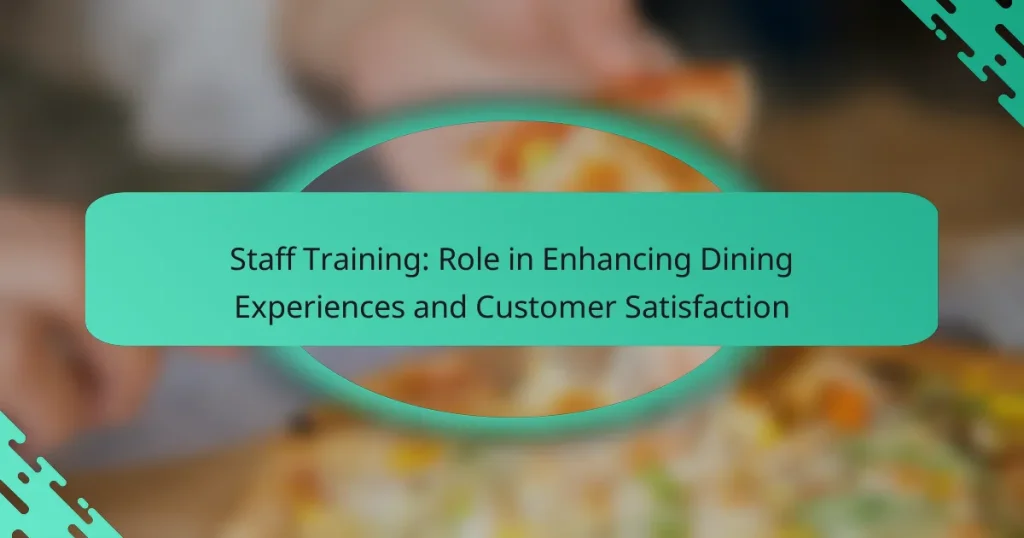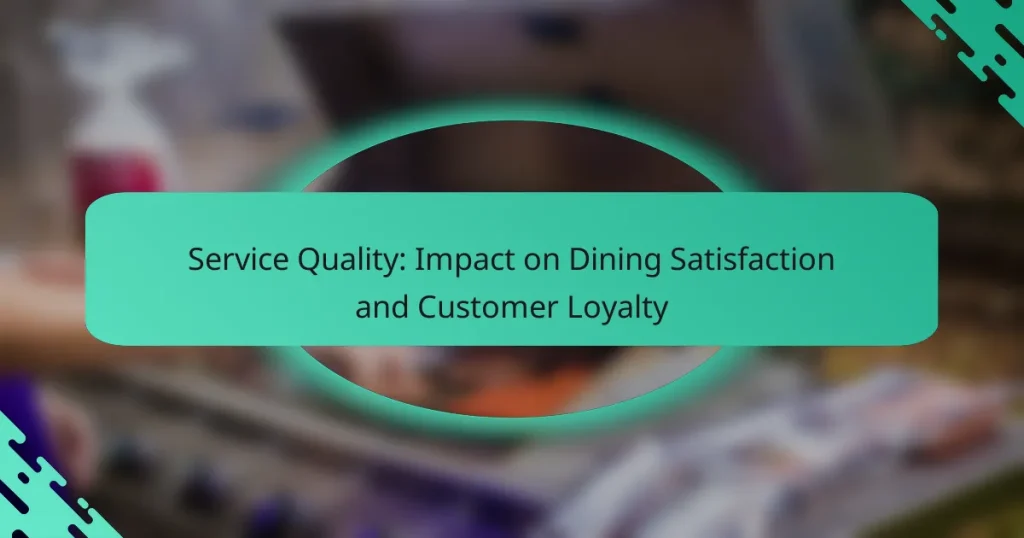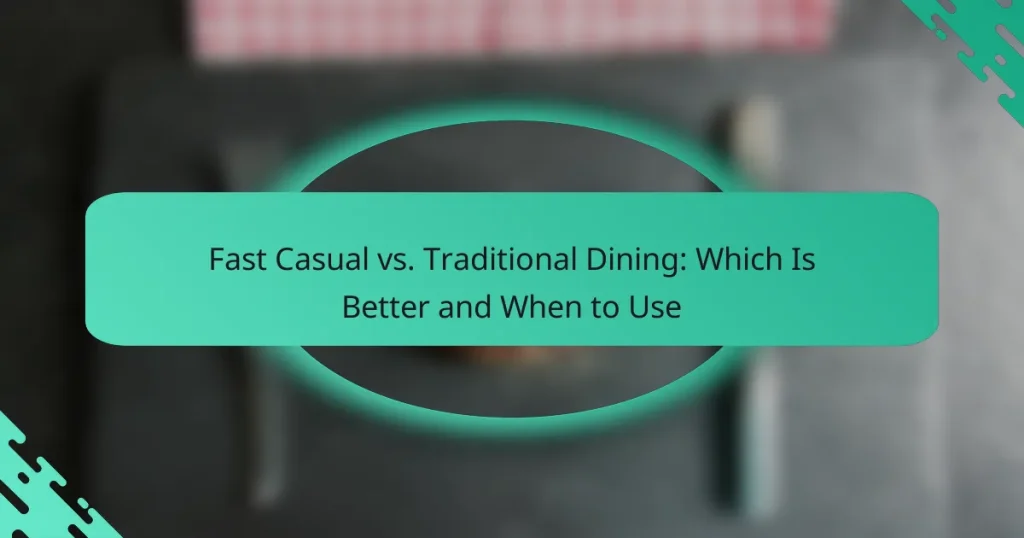Service quality in restaurants is essential for creating a memorable dining experience. By focusing on staff training, leveraging customer feedback, and establishing clear service standards, restaurants can significantly enhance their overall service. Key attributes such as speed, professionalism, and ambiance play a vital role in meeting and exceeding customer expectations.
Service Quality Feedback: Channels, Importance and Best Practices
Staff Training: Role in Enhancing Dining Experiences and Customer Satisfaction
Service Quality: Evaluation Methods, Metrics and Standards
Service Quality: Impact on Dining Satisfaction and Customer Loyalty
Fast Casual vs. Traditional Dining: Which Is Better and When to Use
How can restaurants improve service quality in New York?
Restaurants in New York can enhance service quality by focusing on staff training, utilizing customer feedback, establishing service standards, integrating technology, and optimizing menu design. These strategies help create a more efficient and satisfying dining experience for customers.
Staff training programs
Effective staff training programs are essential for improving service quality in restaurants. Training should cover customer service skills, menu knowledge, and problem-solving techniques. Regular workshops and role-playing scenarios can help staff practice and refine their skills.
Consider implementing a mentorship system where experienced staff guide new employees. This approach fosters a supportive environment and ensures that service quality remains consistent across the team.
Customer feedback systems
Implementing customer feedback systems allows restaurants to gather insights directly from diners. Surveys, comment cards, and online reviews can provide valuable information about service quality and areas for improvement. Actively encouraging feedback helps customers feel valued and engaged.
Consider using digital platforms to streamline feedback collection and analysis. Tools like QR codes on receipts can direct customers to online surveys, making it easy for them to share their experiences.
Service quality standards
Establishing clear service quality standards is crucial for maintaining consistency in a restaurant. These standards should outline expectations for staff behavior, response times, and overall customer interaction. Regularly reviewing and updating these standards ensures they remain relevant.
Consider creating a service quality checklist for staff to follow during shifts. This can include greeting customers promptly, checking in during meals, and ensuring timely service, helping to reinforce high standards.
Technology integration
Integrating technology can significantly enhance service quality in restaurants. Point-of-sale systems, reservation management software, and mobile payment options streamline operations and reduce wait times. Technology can also facilitate better communication among staff.
For example, using tablets for taking orders can minimize errors and speed up service. Additionally, implementing a customer relationship management (CRM) system can help track preferences and personalize service.
Menu design optimization
Optimizing menu design can improve service quality by making it easier for customers to make decisions. A well-structured menu should highlight popular items, include clear descriptions, and consider dietary restrictions. Visual elements can also enhance appeal and guide choices.
Consider using a layout that groups similar items together and employs strategic pricing. Offering a limited number of daily specials can simplify decision-making and reduce wait times, ultimately enhancing the dining experience.
What are the key attributes of high-quality restaurant service?
High-quality restaurant service is characterized by several key attributes that enhance the dining experience. These include speed of service, staff professionalism, food presentation, and the overall ambiance and cleanliness of the establishment.
Speed of service
Speed of service is crucial in the restaurant industry, as it directly impacts customer satisfaction. Diners typically expect their orders to be taken promptly and food to be served within a reasonable timeframe, often within 15 to 30 minutes for main courses.
To ensure efficient service, restaurants should streamline their processes, from taking orders to food preparation. Staff training on time management and using technology for order tracking can significantly improve service speed.
Staff professionalism
Staff professionalism encompasses the demeanor, appearance, and knowledge of the restaurant staff. Friendly and attentive service can elevate a dining experience, while knowledgeable staff can provide recommendations and answer questions about the menu.
Restaurants should invest in training programs that emphasize customer service skills and product knowledge. Regular evaluations and feedback can help maintain high standards of professionalism among the staff.
Food presentation
Food presentation plays a vital role in the overall dining experience, as visually appealing dishes can enhance enjoyment and satisfaction. Attention to detail in plating, garnishing, and portion sizes can make a significant difference.
Restaurants should consider the use of vibrant colors, contrasting textures, and creative arrangements to elevate their dishes. Consistency in presentation across the menu is also important to establish a recognizable brand identity.
Ambiance and cleanliness
The ambiance of a restaurant, including lighting, music, and decor, contributes to the overall experience. A well-designed space can create a welcoming atmosphere that encourages diners to relax and enjoy their meals.
Cleanliness is equally important, as it reflects the restaurant’s standards and attention to detail. Regular cleaning schedules and inspections should be implemented to ensure that both dining areas and restrooms meet high hygiene standards.
How does customer feedback influence restaurant service quality?
Customer feedback is crucial for enhancing restaurant service quality as it provides direct insights into the dining experience. By actively seeking and analyzing feedback, restaurants can identify areas for improvement and adapt their services to meet customer expectations.
Identifying service gaps
Identifying service gaps involves comparing customer expectations with their actual experiences. Common methods include surveys, comment cards, and online reviews. For instance, if patrons frequently mention long wait times, this indicates a gap in service efficiency that needs addressing.
Restaurants can also use mystery shoppers to gain unbiased evaluations of their service. This approach helps pinpoint specific areas where the service may not align with customer expectations.
Enhancing customer satisfaction
Enhancing customer satisfaction requires a proactive approach to addressing feedback. Restaurants can implement training programs for staff based on recurring feedback themes, such as improving communication or food presentation. Simple changes, like adjusting menu descriptions or staff interactions, can significantly boost satisfaction levels.
Additionally, offering personalized experiences, such as remembering regular customers’ preferences, can create a more welcoming atmosphere. This attention to detail often leads to increased customer loyalty and repeat visits.
Implementing changes
Implementing changes based on customer feedback involves a systematic approach. First, prioritize the feedback based on frequency and impact. For example, if multiple customers report issues with a specific dish, it may warrant a recipe revision or removal from the menu.
Next, communicate changes to staff to ensure everyone is aligned with the new standards. Regularly revisiting customer feedback after implementing changes can help assess their effectiveness and guide further improvements.
What role does technology play in enhancing service quality?
Technology significantly enhances service quality in restaurants by streamlining operations and improving customer interactions. Tools like online reservation systems, point of sale systems, and customer relationship management tools help optimize efficiency and elevate the dining experience.
Online reservation systems
Online reservation systems allow customers to book tables conveniently through websites or mobile apps. This technology reduces wait times and helps restaurants manage seating efficiently, leading to improved customer satisfaction.
When implementing an online reservation system, consider features such as real-time availability, confirmation notifications, and integration with other management tools. Popular platforms include OpenTable and Resy, which cater to various restaurant sizes and styles.
Point of sale systems
Point of sale (POS) systems are essential for processing transactions and managing sales data. Modern POS systems often include features like inventory tracking, sales analytics, and employee management, which can enhance overall service quality.
Choosing the right POS system involves evaluating ease of use, customer support, and integration capabilities with other restaurant technologies. Systems like Square and Toast are popular choices, offering flexible pricing models suitable for different restaurant budgets.
Customer relationship management tools
Customer relationship management (CRM) tools help restaurants build and maintain relationships with their patrons. These tools collect data on customer preferences and behaviors, enabling personalized marketing and improved service delivery.
When selecting a CRM tool, look for features such as loyalty programs, targeted promotions, and feedback collection. Solutions like Salesforce and HubSpot can be tailored to fit the specific needs of restaurants, enhancing customer engagement and retention.
What are the best practices for measuring service quality?
Measuring service quality involves various practices that provide insights into customer experiences and operational effectiveness. Effective methods include gathering direct feedback, employing evaluative programs, and conducting systematic reviews to ensure consistent service delivery.
Customer satisfaction surveys
Customer satisfaction surveys are a direct way to gauge how well your restaurant meets guest expectations. These surveys can be conducted online or in-person and typically include questions about food quality, service speed, and overall experience.
To maximize response rates, consider offering incentives like discounts or loyalty points. Aim for a completion rate of around 10-20% for meaningful insights, and analyze trends over time to identify areas for improvement.
Mystery shopper programs
Mystery shopper programs involve hiring individuals to evaluate the service quality anonymously. These shoppers assess various aspects, including staff behavior, cleanliness, and adherence to service protocols.
Implementing such programs can provide unbiased feedback and highlight discrepancies between perceived and actual service quality. Ensure that mystery shoppers are trained to provide detailed reports, focusing on specific criteria relevant to your restaurant’s standards.
Service quality audits
Service quality audits involve systematic evaluations of service processes and interactions. These audits can be conducted internally or by third-party experts and typically assess compliance with established service standards.
Regular audits help identify operational weaknesses and ensure that staff are consistently delivering high-quality service. Consider scheduling audits quarterly and using a checklist to cover key service areas, such as staff training, menu knowledge, and customer engagement techniques.





